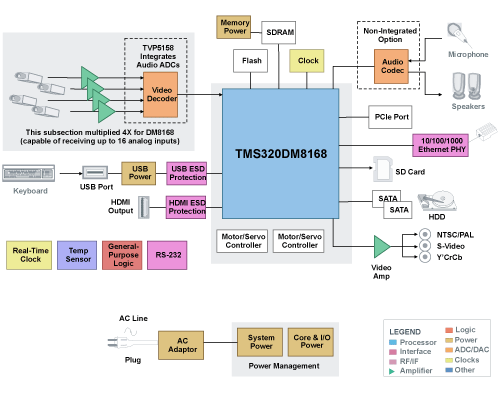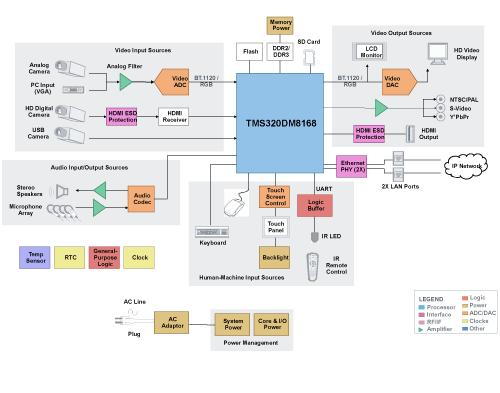http://www.eetasia.com/ART_8800601867_499495_NP_94c296f2.HTM
Video SoC delivers HD quality at low bitrate
Texas Instruments Inc. has rolled out the TMS320DM8168 DaVinci video SoC, which consolidates all of the capture, compression, display and control functionalities of an HD multi-channel system onto a single chip.
Designed specifically for video security and video communications applications, the video SoC offers extreme integration including a 1GHz ARM Cortex-A8 and a 1GHz TI C674x DSP core. This integration of the DM8168 video SoC drastically reduces system electronic BOM costs by 50 percent, as well as reducing board area and power consumption by replacing the functionality of more than 10 discrete components.
The DM8168 video SoC offers up to 4x the video compression performance compared to TI's previous generation industry performance leader, the 1GHz DM6467T, including increased multi-channel density and support for higher resolutions. Combined with an order of magnitude increase in HD video pre- and post-processing, the video SoC delivers unprecedented video performance, enabling higher quality video at lower bitrates for video security and video communications applications. Compared to previous generations of digital video processors, the innovative DM8168 video SoC slashes digital video recorder (DVR) system cost and complexity by providing the capabilities of a 16-channel DVR in a single video SoC with advanced video analytics and enhanced 2D and 3D graphics.
For hybrid security DVR solutions, the device packs simultaneous 16 channels of H.264 high profile D1 encoding with CIF multi-streaming and eight channels of D1 decoding plus video compositing and graphics blending supporting up to three independent displays. The DM8168 also supports three channels of 1080p at 60fps and reduces glass-to-glass latency below 50ms by eliminating off-chip inefficiencies with codec latency of less than 1ms for video communications applications.
Extreme integration including a 1GHz ARM Cortex-A8, 1GHz TI C674x floating-point DSP, several second-generation programmable HD video image co-processors, an innovative HD video processing subsystem and comprehensive codec support including H.264, MPEG-4 and VC1 at HD resolutions. In addition, the SoC packs multiple interfaces including Gigabit Ethernet, PCIe, SATA2, DDR2, DDR3, USB 2.0, MMC/SD, HDMI and DVI that provide flexibility in design implementations.
The device's glueless interface to four TI TVP5158 multi-channel video decoders seamlessly captures up to 16 D1 video channels. TI's TVP5158 decoder automatically controls contrast and reduces noise to improve compression ratios and overall video quality thus eliminating the need for additional FPGAs and external memory while simplifying design and providing more system flexibility.
TI provides the TVP5158 video decoder needed to provide glueless interfacing with the DM8168 video SoC, as well as a full suite ofanalog solutions to address video security or video communications system designs. Specifically designed for the DM8168 video SoC is a new versatile clock generation product that provides all the necessary system clock frequencies, as well as a new video amplifierthat filters for CVBS (composite video broadcast signal), S-video and component video up to 1080p at 60fps or RGB video signals. Both devices will be available upon the release of the DM8168 video SoC. Coupled with easy-to-use software and hardware tools, TI offers all the power management solutions for the processor or the complete system, as well as all the signal chain products necessary to process audio and video signals.
The DM8168 DaVinci video SoC will begin sampling in Q2 to early adopter video security and video communications customers. With pricing significantly less than the components it replaces, the new DM8168 video SoC enables the next-generation of high performance digital video systems.
To accelerate design cycles, TI will offer video security and video communications evaluation modules (EVMs). Each EVM will come complete with a reference hardware board, software, tools and demonstration applications that enable developers to evaluate video processing capabilities and performance, as well as immediately begin application development. Developers will also have access to a complete EVM support package, including a full software framework and design suite that abstracts the internal complexity of the DM8168 video SoC, resulting in simplified management and processing of multiple video channels while accelerating time-to-market.

 Enlarge
Enlarge